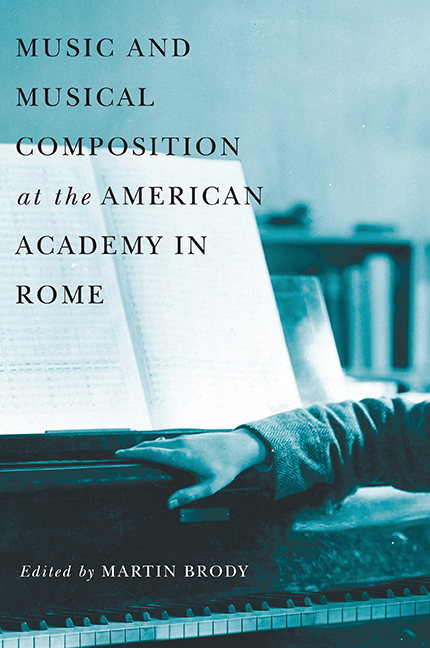Book contents
- Frontmatter
- Contents
- List of Illustrations
- Introduction
- Part One A History of the Rome Prize
- Part Two Origins, Ideology, Patronage
- Part Three Two Case Studies in Internationalism
- Part Four Primary Sources
- 7 What They Said: American Composers on Rome
- 8 The New Music Scene in Rome and the American Presence since World War II: Excerpts from a Roundtable, Moderated by Richard Trythall
- 9 For the Academy
- 10 Two Visits in 1981
- 11 Music Resources at the American Academy in Rome
- Appendix: Composers at the American Academy in Rome, 1921–40
- Selected Bibliography
- List of Contributors
- Index
8 - The New Music Scene in Rome and the American Presence since World War II: Excerpts from a Roundtable, Moderated by Richard Trythall
from Part Four - Primary Sources
Published online by Cambridge University Press: 25 October 2017
- Frontmatter
- Contents
- List of Illustrations
- Introduction
- Part One A History of the Rome Prize
- Part Two Origins, Ideology, Patronage
- Part Three Two Case Studies in Internationalism
- Part Four Primary Sources
- 7 What They Said: American Composers on Rome
- 8 The New Music Scene in Rome and the American Presence since World War II: Excerpts from a Roundtable, Moderated by Richard Trythall
- 9 For the Academy
- 10 Two Visits in 1981
- 11 Music Resources at the American Academy in Rome
- Appendix: Composers at the American Academy in Rome, 1921–40
- Selected Bibliography
- List of Contributors
- Index
Summary
Mauro Bortolotti, Composer, Cofounder of Nuova Consonanza
Rebirth after the War
For those of us who were students then, the postwar years meant a rediscovery of freedom, the departure of a regime that had kept cultural frontiers closed for a long time. The censorship had been severe: no poetry, no music from abroad. In 1950 we were still students, although we were pretty advanced, and we craved to know what was going on in Europe and America. To this end, a group of young composers studying at the Santa Cecilia Conservatory, myself included, decided to do something to create systematic opportunites to increase our awareness, beyond what our individual contacts would allow. Although it didn't become offi cial until a few years later, we created an association of new music performers and composers in the late fi fties, Nuova Consonanza. The founders were Domenico Guaccero, Franco Evangelisti, the often-forgotten Mario Bertoncini, and Daniele Paris, who was to become Nuova Consonanza's favorite conductor (a fate that almost ended his composition career). Egisto Macchi came in later. All but Evangelisti were students of Petrassi. The name, Nuova Consonanza, bore a slight hint of criticism for the current contemporary music dogmas, such as serialism. At that point, there was no aleatoric music and no improvisation—and electronic music was in its infancy.
It soon became clear that the only way we could break into the academic Italian music world was by making a new initiative. We couldn't afford to produce our programs at the major musical institutions. The costs of putting something on at Santa Cecilia would have sent us into bankruptcy. So we chose to ask the foreign academies in Rome if we could count on their help—especially to use their rooms as concert halls. The American Academy, the Goethe Institute, and the Japan Cultural Institute in Rome agreed fi rst. They were eager to make their facilities available—though we usually had to bring our own chairs! But this allowed us, even required us, to hear new music from abroad, since each concert hosted by an academy had to include music by both Italian composers and the composers of the hosting institution's nation.
- Type
- Chapter
- Information
- Music and Musical Composition at the American Academy in Rome , pp. 267 - 275Publisher: Boydell & BrewerPrint publication year: 2014

